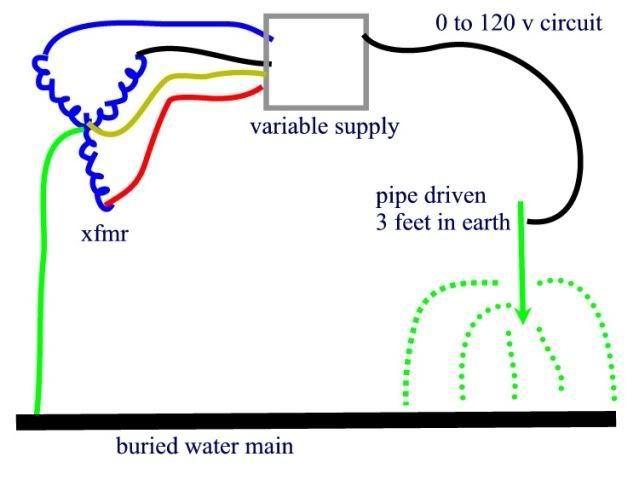crossman gary
Senior Member
Okay, I did the following experiment which was initiated from the "grounding electrode conductor question" thread. The point was to determine if a fault path through earth could trip an OCPD.
I took a 10 foot piece of 1/2" rigid and cut in in half. I went to a spot outside the door to a grassy area. This is black clay soil in southest texas. The soil was moderately damp. Photo below:

I drove one of the 1/2" rigid pipes about 3 feet into the ground. The pipe is 5 feet long, notice 2 feet still sticking up. It went into the ground fairly easily, but I did use a sledge hammer to get'er in, but nothing difficult. Then I took a simpson meter on the Rx1 scale, zeroed it, and hooked it from the pipe to a brass water spigot on the side of the building.
Reading: 2 ohms approximately
The water piping in the building is steel. It goes up inside the brick wall to the rest of the plumbing - connected to the water main coming in on the other side of the building. I am guessing the city main is steel, and it runs in front of the building along the street.
Electrical service to building is 480Y/277. Inside there is a 208Y/120 xfmr. This xfmr has Xo bonded to the water pipe coming in the building. The point is, there is a whole lot of buried steel pipe acting as the grounding electrode.
So again, 2 ohms from the driven pipe THROUGH THE EARTH to the closest plumbing pipe in the area. Photo below:
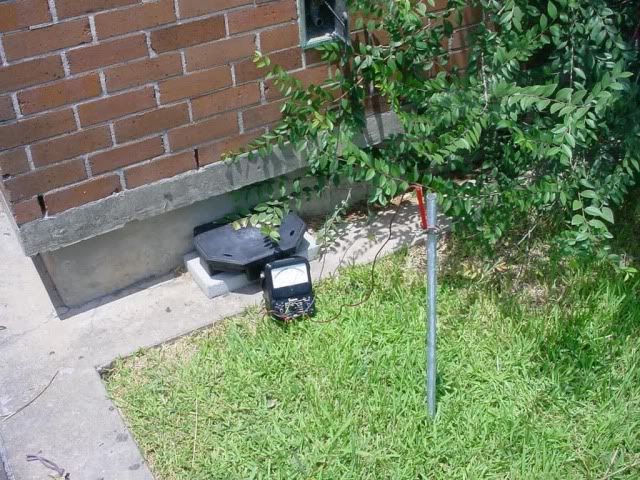
Close-up of meter:
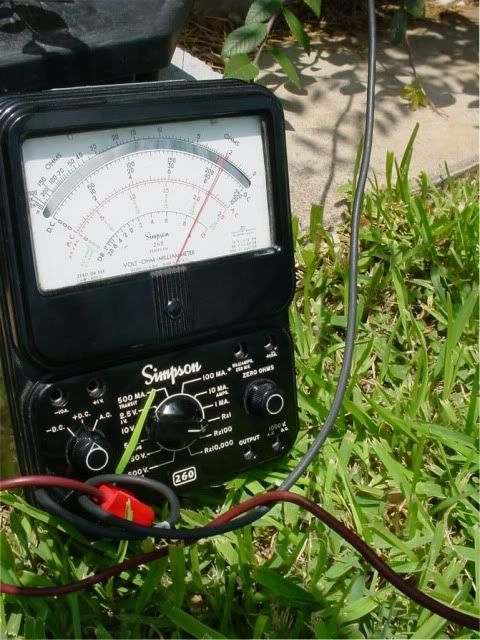
So I took a #8 copper wire to the pipe:
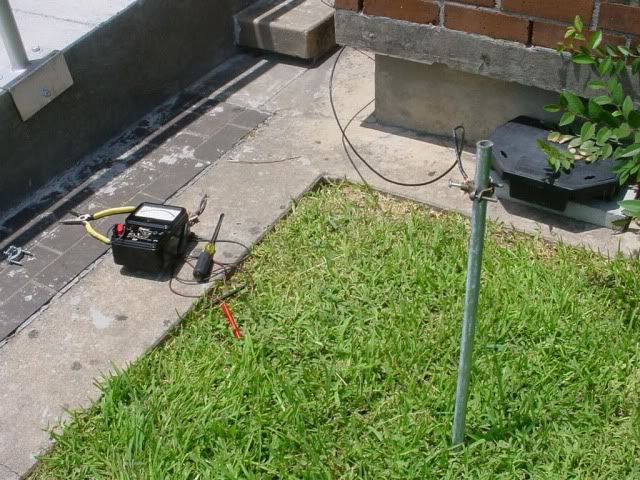
Connected it in the building to our experiment machine:
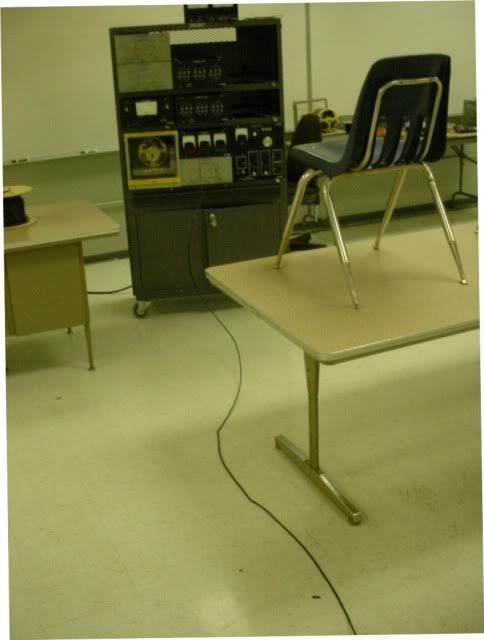
Here is the connection to the voltage source. The power source is fed through a subpanel from the 208Y/120 xfmr. It has a variable supply, I can go from 0 to 120 volts to neutral/ground. There is an OCPD in the power supply, it is supposed to be 15 amps but I suspect it trips a little sooner than that. I connected one phase of the supply through an ampmeter to the pipe via the #8.
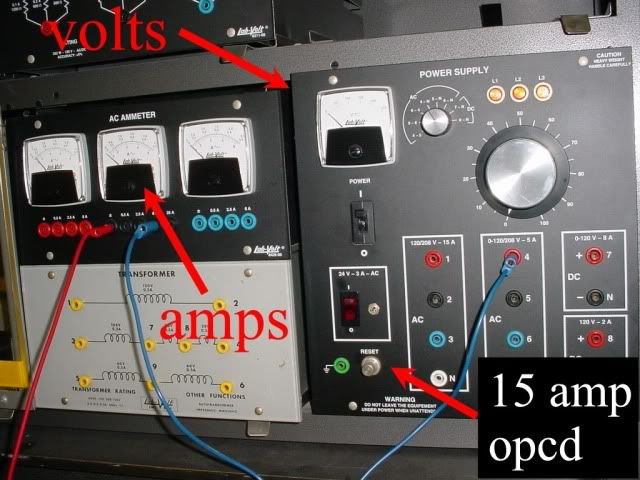
As I slowly turned the voltage up to 50 volts, the current slowly went up to 6 amps. (these meters have not been calibrated in awhile, so I guess we may have a +/- 10% error here.
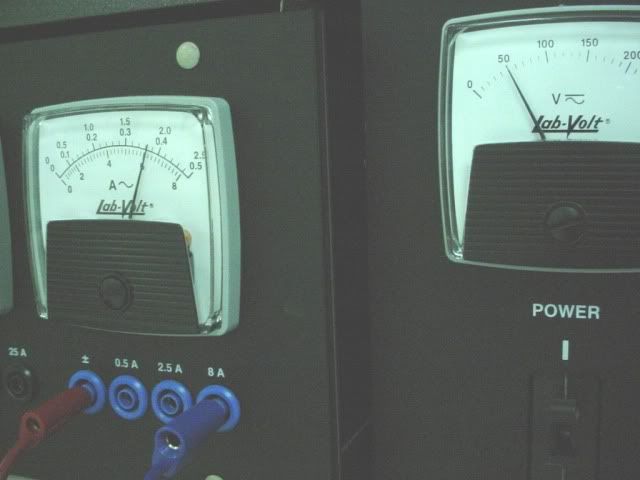
After playing around with these voltage/current levels a bit, I went ahead and cranked the voltage source up to 120 volts. The OCPD kicked out. Math says that if 50 volts gives 6 amps, 120 volts would be about 14 amps. Like I said, the meters are not calibrated, and the OCPD is not a normal breaker, it is more of a "reset" type button that kicks out when there is too much current.
Yeah, this is a fairly non-rigorous experiment, but a good amount of current certainly was flowing through the earth path.
Never say that 120 volts cannot trip an OCPD device through the earth. It can under proper circumstances.
Also, I did not "cheat" on any of this. No hidden wires, nothing like that. This is legit.
I took a 10 foot piece of 1/2" rigid and cut in in half. I went to a spot outside the door to a grassy area. This is black clay soil in southest texas. The soil was moderately damp. Photo below:

I drove one of the 1/2" rigid pipes about 3 feet into the ground. The pipe is 5 feet long, notice 2 feet still sticking up. It went into the ground fairly easily, but I did use a sledge hammer to get'er in, but nothing difficult. Then I took a simpson meter on the Rx1 scale, zeroed it, and hooked it from the pipe to a brass water spigot on the side of the building.
Reading: 2 ohms approximately
The water piping in the building is steel. It goes up inside the brick wall to the rest of the plumbing - connected to the water main coming in on the other side of the building. I am guessing the city main is steel, and it runs in front of the building along the street.
Electrical service to building is 480Y/277. Inside there is a 208Y/120 xfmr. This xfmr has Xo bonded to the water pipe coming in the building. The point is, there is a whole lot of buried steel pipe acting as the grounding electrode.
So again, 2 ohms from the driven pipe THROUGH THE EARTH to the closest plumbing pipe in the area. Photo below:

Close-up of meter:

So I took a #8 copper wire to the pipe:

Connected it in the building to our experiment machine:

Here is the connection to the voltage source. The power source is fed through a subpanel from the 208Y/120 xfmr. It has a variable supply, I can go from 0 to 120 volts to neutral/ground. There is an OCPD in the power supply, it is supposed to be 15 amps but I suspect it trips a little sooner than that. I connected one phase of the supply through an ampmeter to the pipe via the #8.

As I slowly turned the voltage up to 50 volts, the current slowly went up to 6 amps. (these meters have not been calibrated in awhile, so I guess we may have a +/- 10% error here.

After playing around with these voltage/current levels a bit, I went ahead and cranked the voltage source up to 120 volts. The OCPD kicked out. Math says that if 50 volts gives 6 amps, 120 volts would be about 14 amps. Like I said, the meters are not calibrated, and the OCPD is not a normal breaker, it is more of a "reset" type button that kicks out when there is too much current.
Yeah, this is a fairly non-rigorous experiment, but a good amount of current certainly was flowing through the earth path.
Never say that 120 volts cannot trip an OCPD device through the earth. It can under proper circumstances.
Also, I did not "cheat" on any of this. No hidden wires, nothing like that. This is legit.

